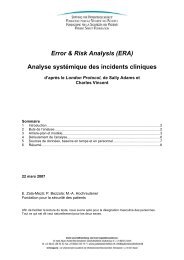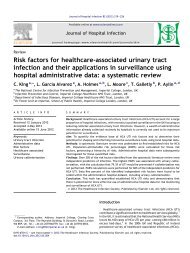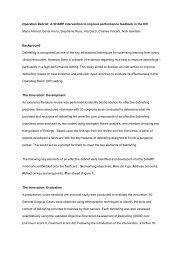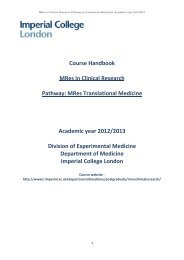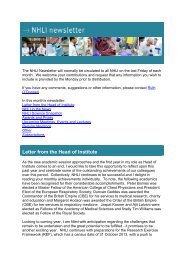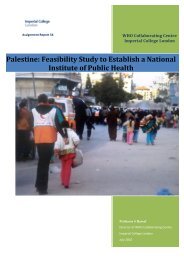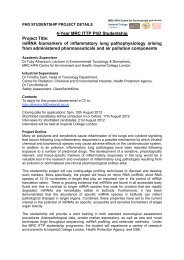QOF Plus Year 1 - Imperial College London
QOF Plus Year 1 - Imperial College London
QOF Plus Year 1 - Imperial College London
You also want an ePaper? Increase the reach of your titles
YUMPU automatically turns print PDFs into web optimized ePapers that Google loves.
How might a local <strong>QOF</strong> operate in practice?There is ongoing debate about how a local <strong>QOF</strong> could work in practice. The Department of Healthhas proposed that to help address local health needs more effectively, PCTs should be able toselect local indicators from a national menu of indicators, for use in local voluntary incentiveschemes (DoH, 2008).An alternative is for indicators to be developed locally by PCTs. However, there are practicallimitations associated with this approach including:the need for technical expertise in the development of evidence-based indicators andbusiness rules for extraction of clinical data from GP systems;the IM&T support required to extract data from clinical systems and to link this withpayment calculations (DoH, 2008).Why have a local <strong>QOF</strong> for Hammersmith and Fulham?Evaluations of recently introduced LES and local Shared Care schemes (including CVD PrimaryPrevention, Smoking Cessation and Alcohol) in Hammersmith and Fulham highlighted a numberof problems with these schemes, in terms of their complexity and design and the level of uptakeby practices. These highlight a need for widespread implementation in a way that is easilyunderstood. There is also a need to reduce health inequalities and recognition that <strong>QOF</strong> may be avehicle to achieve this. Although it has been proposed that PCTs should have flexibility to selectlocal indicators from a national menu published by NICE, the infrastructure required to supportdevelopment of local <strong>QOF</strong>s through this approach is not anticipated to be in place until 2011/12at the earliest (DoH, 2008). It was therefore proposed that NHS Hammersmith and Fulham woulddevelop a local <strong>QOF</strong> scheme to run initially for 3 years from 2008/9-2010/11, with technicalexpertise in indicator development being provided by the Department of Primary Care and SocialMedicine at <strong>Imperial</strong> <strong>College</strong> <strong>London</strong> in conjunction with national and international experts in thisfield, and IM&T support being provided by the PCT’s Health Informatics Team.The need for clinical engagementEffective local clinical engagement is crucial to the success of service improvement initiatives andits integral role has been highlighted in the competencies of World Class Commissioning (DoH,2008) and by The NHS Alliance (2003) which states that “front-line clinical staff should beeffectively involved in redesign, service provision and in ensuring services are used costeffectively.”The NHS Alliance further highlights that the engagement of front-line professionalsat a strategic level would allow PCTs to draw on a bank of untapped knowledge resulting from thewider experiences of primary care. The involvement of local practices in helping shape <strong>QOF</strong>+ wastherefore seen as a central element of the design and development of the scheme.6



